By Barb Elliot
Monarch butterflies are on the move. I’ve been seeing them fly through my yard, above fields, over traffic jams, through neighborhoods. These fragile creatures are heading southwest toward their ancient wintering grounds, stopping along the way to rest and sip nectar from late-blooming plants. The peak of Monarch migration through our area is mid- to late-September, but you may still see Monarchs if you spend time outdoors.
This generation of Monarchs is different from those we saw in the summer. Those Monarchs were intent on mating and laying eggs and only lived from two to six weeks. But this generation will live for about eight months and is in the midst of an epic journey. They will not mate, but instead are programmed to fly to a place they have never been before – mountains in Mexico where millions of Monarchs will roost together to survive the winter. Some of them will fly as far as 3,000 miles!
Migrating Monarchs depend on nectar sources along their route for energy to complete the journey. Next spring, the Monarchs that survive migration and the winter in Mexico will fly north into Texas, mate, lay eggs on milkweed plants and die. Caterpillars will hatch from the eggs, eat milkweed, change into chrysalises, and emerge as adult Monarch butterflies that in turn fly north, mate, lay eggs and die. The next generation will make its way farther north and east, repeat the cycle, and the U.S. and Canada east of the Rocky Mountains will once again be populated with Monarch butterflies during spring and summer. The great, great, grandchildren of the Monarchs that are now flying south will be the ones we see during their migration to Mexico next fall. Though some butterfly species complete a one-way migration, Monarchs are the only butterfly species in the world that accomplishes a two-way migration.
Migrating Monarchs face many threats, including bad weather, predators, and lack of food, but some have always survived to continue the species. However, if current
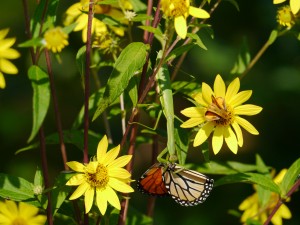
This Monarch, caught by a praying mantis, won’t make it to Mexico. Cape May, NJ, September 12, 2012 Photo © Barb Elliot
trends continue, we are in danger of losing Monarchs altogether. This year’s population, according to Chip Taylor, director of Monarch Watch, is about half the long-term average. Monarch numbers have been declining since the late 1990’s, but the downward trend has accelerated since 2003. Monarch Watch indicates the major cause for the decline is loss of food sources in the U.S. from development, routine mowing along roadsides, and the widespread use of herbicides that kill milkweed plants, the Monarch caterpillar’s only food. Increased use of genetically modified corn and soy crops on mid-west farms is likely responsible for much of the population decline. These crops are engineered to survive the spraying of herbicides which kill milkweeds and other plants growing in the fields. Since the year 2000, about 100 million acres of former Monarch milkweed habitat in agricultural areas have been lost in this way. The milkweed habitats that are left are not sufficient to sustain the larger Monarch populations of the 1990s.
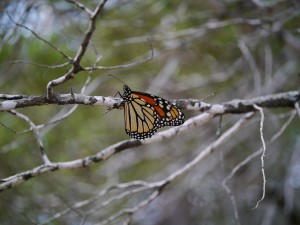
This Monarch near Austin, Texas is much closer to the Mexican wintering grounds, but faces drought conditions with few flowers to provide nectar. October 9, 2012. Photo © Barb Elliot
Monarchs need our help! Monarch Watch has suggested a national effort to plant milkweeds in as many locations as possible, and have instituted a campaign called Bring Back the Monarchs. It’s not too late to get some milkweed started in your garden this fall, or you can wait till spring. Perhaps you can think of additional locations that milkweeds could be planted, such as in schoolyards, parks, business properties, or roadsides. Milkweeds do well in containers, too, so a large space is not necessary. Of the five species of native milkweeds in my yard, my favorite is Swamp Milkweed (Asclepias incarnata). I found many Monarch eggs on my Swamp Milkweed this summer and also noticed that adults seemed to prefer the long-blooming Swamp Milkweed flowers’ nectar to that of other flowers in my yard.
You can help migrating Monarchs and other fall-flying butterflies by providing late-blooming nectar plants such as native asters and goldenrods. Consider adding flowering plants to your yard that provide a succession of blooms from spring through fall. You’ll be providing nectar not just for migrating Monarchs, but also for the Monarchs and other butterflies that fly earlier in the year. Check the native perennials on our Backyards for Nature plant list for some suggestions.
If you add milkweeds for Monarch caterpillars and nectar plants for the adults, you will be helping to make more Monarchs. You’ll not only have the satisfaction of knowing you’re helping to increase the population, but you’ll be able to see these marvelous butterflies in your yard and even witness their metamorphosis of egg to caterpillar to chrysalis to butterfly! You can also have your yard certified as a Monarch Waystation through Monarch Watch. This will mark your contribution to preserving Monarchs and show others how they, too, can help one of the true treasures of the natural world.
Below is a list of the locally native species of milkweed that I grow in my yard.
|
Locally Native Milkweed Plants** |
|||
| Botanical Name | Common Name | Bloom Color & Period | Light & Soil Conditions |
| Asclepias incarnata | Swamp Milkweed | Pink flowers; June & July | Part to full sun, moist soil |
| Asclepias tuberosa | Butterfly Milkweed | Orange flowers; June to August | Sun, dry to average soil |
| Asclepias verticillata | Whorled Milkweed | White flowers; July & August | Sun, dry to average soil |
| Asclepias purpurascens | Purple Milkweed | Dark pink/purple flowers; June & July | Part to full sun, dry/ average/moist soil |
| Asclepias syriaca* | Common Milkweed | Pink flowers; June & July | Sun, dry soil |
| *Spreads rapidly by underground rhizomes; best for large areas with other flowers and grasses | |||
| **All are deer resistant | |||
For a list of local nurseries that sell native milkweeds, click here.
For info on how to gather and plant milkweed seeds, click here.

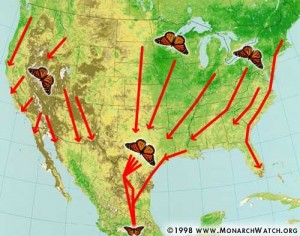
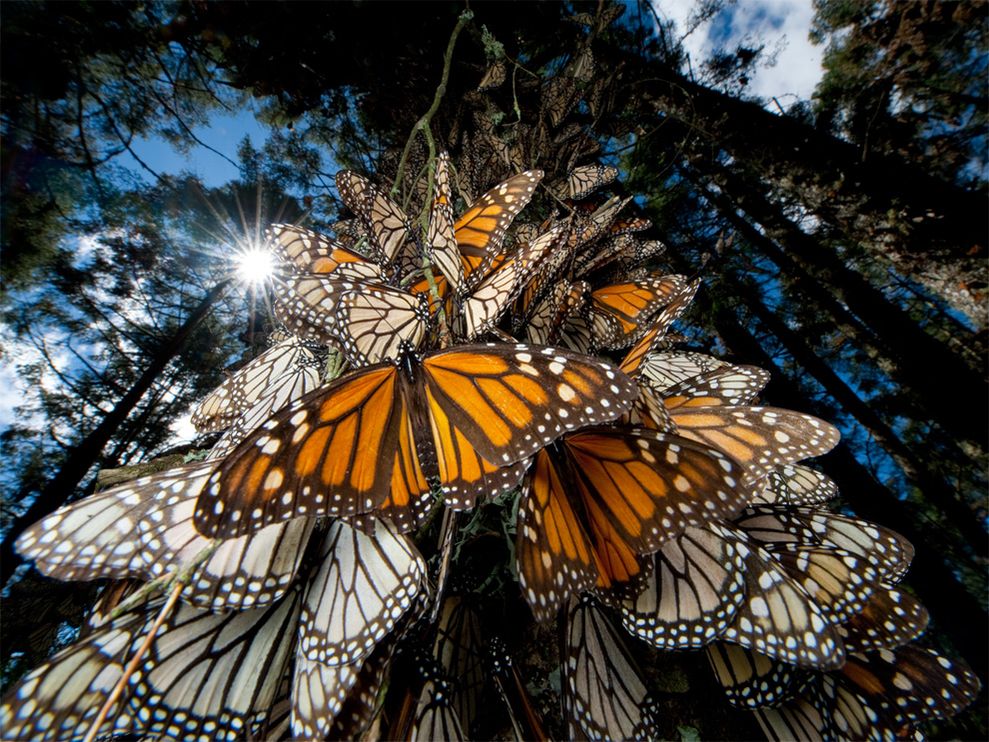

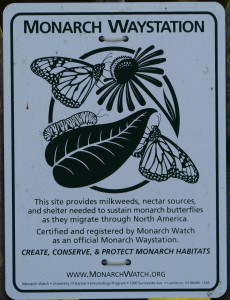
I have beds of wildflowers on my septic field (sand mound) instead of grass. Last year I noticed Asclepias incarnata, which I had not planted, so evidently it arrived on the wind. This year there were several plants, so apparently it likes the location. I saw monarch caterpillars on one of the plants in early September, and egg clusters a bit later, so it looks like the plants are supporting multiple generations. I plan to transplant some of next year’s seedlings to our township’s rain garden, in order to spread the wealth for the monarchs.
Susan, it’s great to hear that you had Swamp Milkweed volunteers and then found Monarch caterpillars. I love your plan to transplant seedlings to your township’s rain garden and as you say, spread the wealth for the Monarchs!
Thank you for the fantastic information! In the native plants garden at my local nature center, all of the milkweed was overcome by aphids this year. There were no caterpillars, as the leaves were completely covered and destroyed by these insects. Aside from the use of chemical insecticides, what can I do to prevent this from happening again next year?
Becky, I haven’t had to deal with this problem yet, but from reading about it, it seems like there are a few non-checmical approaches that you can try. Depending on the situation at your nature center, you may want to try one or more of these. One is to direct a strong spray of water at the aphids to get them off the plants. Another is to squash the aphids on the plant, squeezing them with your fingers. You’d need to wear gloves for this as the aphids will stain your fingers orange. The third approach is to cut infested parts off the plant off and dispose of them along with the aphids in the trash.
I agree with you that chemical insecticides should not be used as these would harm the monarchs, and even organic and homemade insecticides sound like they could put the caterpillars at risk. I think using one of the physical approaches is best. I’d love to hear back from you next year and see how your milkweeds fare and how these methods work for you.
Barb